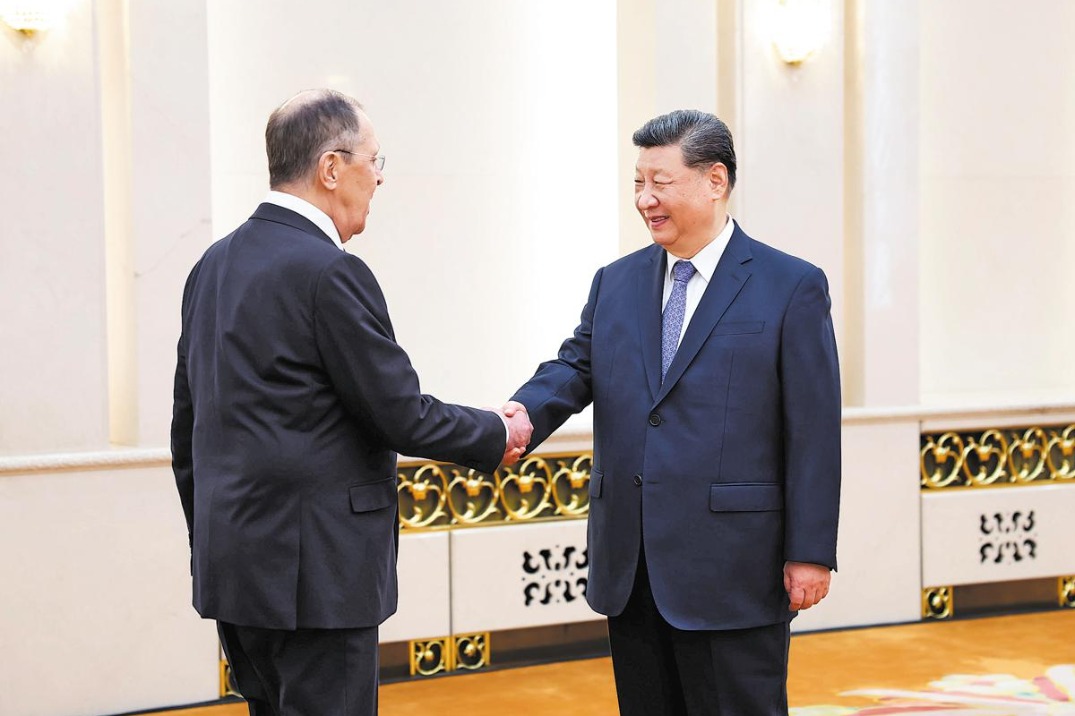Part of the problem or part of the solution
China and the US must find a way to reduce their differences that are impeding efforts to address the existential threats to humanity


Fifty years ago, the People's Republic of China restored its seat in the United Nations. Since then, China's role on world stage has grown commensurate with its economic rise. As its economy has grown to be the world's second-largest, China has become the second-largest contributor to the UN budget and the largest troop contributor to the UN peacekeeping operations among the five permanent members of the UN Security Council. This has been a great achievement. It is also a great inspiration for many developing countries.
In that process, China has been a great beneficiary of multilateralism, the liberal trading regime in particular. Multilateralism represented by the UN, I argue, is now entering the fourth phase, "Multilateralism 4.0" under the uni-bipolarity, that is still dominated by the United States but with China catching up close.
"Multilateralism 1.0" was established after the end of World War II and maintained under the bipolarity of the US and the former Soviet Union during the Cold War period. The US-China détente in the early 1970s was an instrumental factor that facilitated China's restoration in the UN and the end of the Cold War. Subsequently, "Multilateralism 1.0" transitioned to "Multilateralism 2.0"under the unipolarity of the US in the initial post-Cold War period of the 1990s. "Multilateralism 2.0" was productive in global norm-making. Examples include the expansion of the UN's peacekeeping operations, the indefinite extension of the Nuclear Non-proliferation Treaty, the adoption of the Comprehensive Nuclear Test Ban Treaty, the establishment of the Organization for the Prohibition of Chemical Weapons, as well as the Beijing Declaration on Women's Rights and the Millennium Development Goals. Unfortunately, however, it turned out to be short-lived due to the growing strains in the relations between the major powers.
At the start of the new millennium, the emerging uni-/multi-polarity produced "Multilateralism 3.0"that was defined by the differences among major powers hampering consensus-building on most of global and regional challenges.
In the evolution of each of these four phases, China has played a different but distinct role. At its heart lies the evolution of the US-China relationship. Growing competition in the relationship was a critical factor that led to the short duration of "Multilateralism 2.0" and its transition to "Multilateralism 3.0"and now onto "Multilateralism 4.0". "Multilateralism 4.0" has yet to take a concrete shape, as the uncertainty and volatility in US-China relations is too great to allow a new order to be defined. The old order has faded away but the new order has not yet arrived.
What is certain is that the US-China relationship will be the key variable in the formation of "Multilateralism 4.0". But it is hard to predict how the relationship between the US and China and their respective relations with other countries will evolve. On a growing number of global and regional issues, it appears that elements of competition show signs of expanding, some of which could develop into confrontation.
This is worrisome, as the global challenges with the wide scope and the deep intensity are many and complex. Topping the list are the existential threats against the humanity such as the global unsustainability crisis that is responsible for climate change, weapons of mass destruction, terrorism, and the unchecked emerging disruptive technologies. Global challenges require global solutions. For that, global leadership is needed now more than ever before to restore global consensus.
The US and China, the two most powerful states, must find a way to manage their relationship, enhance their cooperation and prevent their competition and confrontation from spiraling out of control. On any global or regional issue of importance to the international community, US-China understanding is a necessary minimum condition to enable a much needed global consensus to be reached. Given the scope and intensity of the challenges involved, no one country, no matter how powerful it is, can meet them alone. Working together is the only way forward. But that is easier said than done.
Obviously it takes the two to tango. At the moment, however, both sides seem to argue the ball is in the other's court. This is wrong, simply because humanity does not have much time left for action to escape the self-imposed perils of existential threats. Before asking the other side to do something first, both sides should ask themselves what should be done to build confidence with the other side. For that, both China and the US have the following three tasks to do.
The first is the need for self-reflection. Two mismatches of self-perceptions must be addressed. For China, there seems to be a gap between China's own perception about its abilities and international responsibilities on the one hand and the expectations of the international community on the other. Special care also needs to be taken to project its national image to the world in a more universally appealing and attractive way. For the US, the view is increasingly conspicuous that the gap is perceived to be widening between its overseas commitments and its capabilities. The withdrawal from Afghanistan is the most recent example of the US rebalancing.
Second, the US and China should step up efforts to find more common ground. There exist a number of global challenges on which their mutual interests can converge and the urgency of collective action is high. Climate mitigation and adaptation actions are one such example. Another is how to prevent and counter the emerging risk of terrorists acquiring weapons of mass destruction and using cyberhacking or other disruptive technologies.
Last but not least, China and the US need to sit down to talk to, not past, each other. There is no shortcut but to talk for problem-solving. Dialogue can start on the issues where the common grounds are found.
The humanity is facing a daunting and imminent task to overcome the existential threats. We have no time to lose. The US and China share the historic responsibility to get "Multilateralism 4.0" right, and make the world a safer, more secure and better place for all. Failure is not an option.
The author is former under secretary-general of the United Nations. The author contributed this article to China Watch, a think tank powered by China Daily. The views do not necessarily reflect those of China Daily.
Contact the editor at editor@chinawatch.cn


































